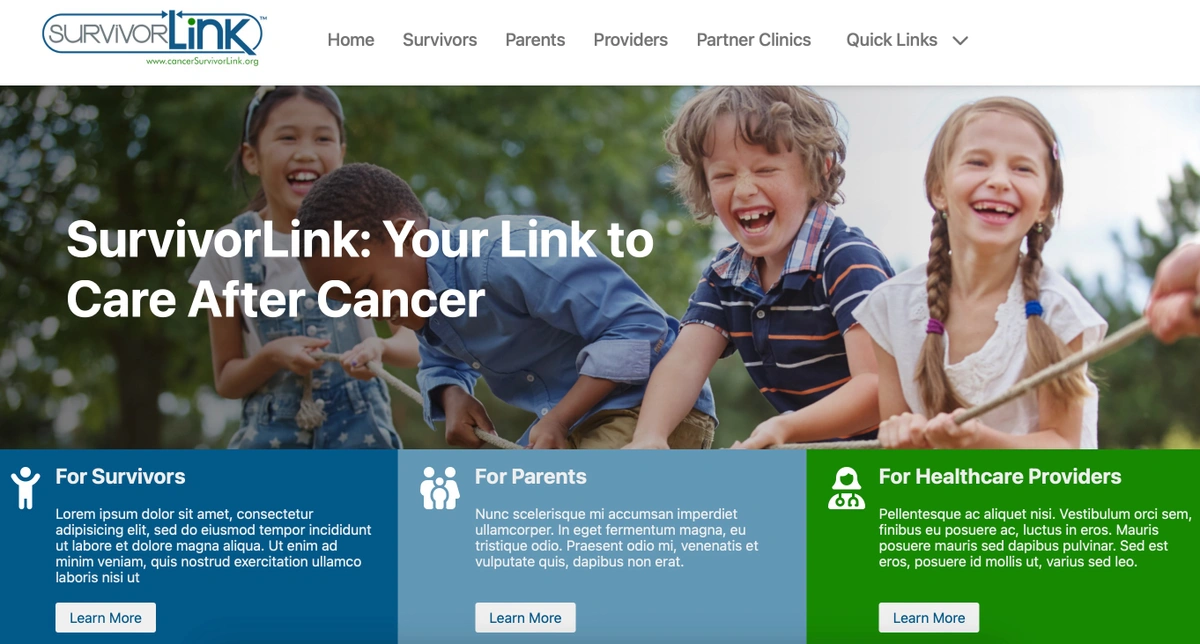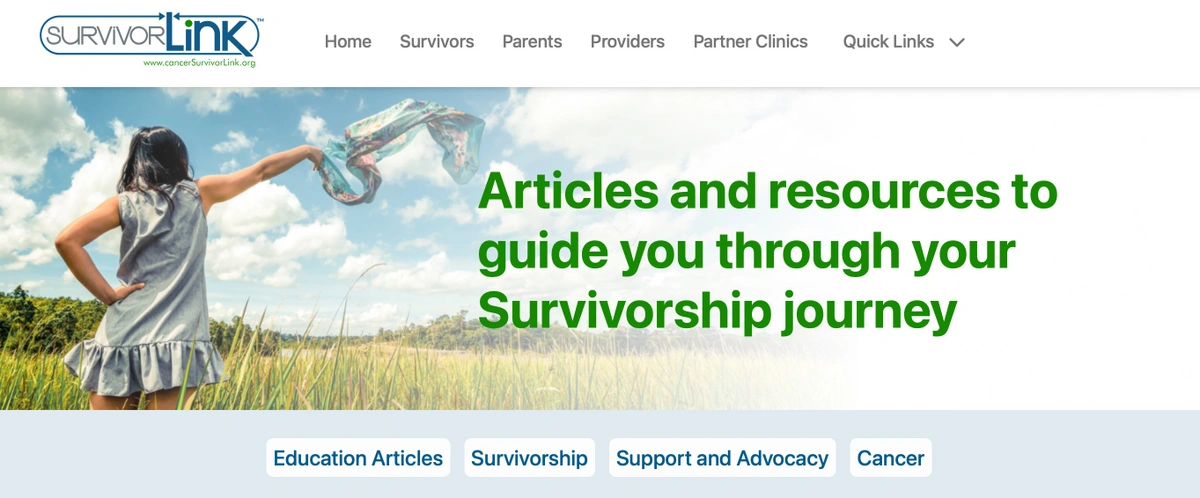Learn how MDHearing Uses ButterCMS to Reduce Organizational Overhead and Continuous A/B Testings for a 15% lift in revenue!
-
Eliminated The Need for Heavy Backend Development
-
API Debugger and Preview Mode Sped Up Creation
-
Built-In Features Made for a Highly Interactive Website

- Hospitals and Health Care
- Angular
- Atlanta, GA
Founded in 2002, Himformatics plans, governs, and optimizes the complex technologies required to support patient-centric healthcare experiences. With astounding dedication to accessibility and UX, the team at Himformatics has engineered solutions for over 200 clients ranging from children's hospitals to academic medical centers. Every project at Himformatics demands an approach as unique as the client’s vision. So, when the team was tasked with designing a new interactive website for SurvivorLink — a cancer survivorship project funded primarily by grants and donations — Himformatics chose ButterCMS for its low cost and high flexibility.
Executive Summary
A Good Cause Deserves a Better Site
Software engineer Michael Palgon took on the SurvivorLink project with one goal: Create a user-friendly website to help pediatric cancer survivors connect with crucial resources in their area — and do it on a limited budget.
Michael sought a CMS that would streamline frontend development, selecting ButterCMS for its flexibility and built-in features, like collections and components. Within hours of starting, he was effortlessly organizing droves of partner clinics and educational resources and creating reusable layouts that fit the project’s exact needs.
The results speak for themselves: a revamped website that’s more interactive and accessible than ever. Through ButterCMS, site admins (healthcare professionals, a not marketing team) now have full control over site content without having to request content changes from Michael. Site admins can add partner clinics themselves now, and they’ll automatically populate into the searchable database thanks to the integrated Google Maps API. Plus, mountains of articles and news pieces have been easily sorted thanks to a collection of tags that delineate between survivor, parent, and healthcare provider
As the SurvivorLink project nears completion, Michael is now working on a SurvivorLink mobile app. ButterCMS’s headless architecture will enable him to reuse and repackage the work he has put in, and focus on the mobile app instead of the backend.
Business Challenges
Finding a Flexible Solution for a Fast Start
At its core, Himformatics is a healthcare IT consulting company. Among the many services they offer, when a hospital or other healthcare organization can’t find an off-the-shelf solution that suits their needs, they turn to the team at Himformatics to build it for them. When they do, software engineer Michael Palgon is the one who takes the lead on execution and development — just like he did with SurvivorLink.
Operated by the Aflac Cancer and Blood Disorders Center at Children’s Healthcare of Atlanta, and in coordination with Emory University, SurvivorLink is an application originally launched in 2009 to connect pediatric cancer survivors with resources and healthcare providers who can help children and their families improve outcomes, manage risk factors, and get access to much-needed social and emotional support.
The old SurvivorLink website got the job done, but the team behind it knew that fulfilling an outstanding wishlist of features and modernizing its UI would go far in improving the service for survivors and providers alike. But, being mostly funded by donations and grants, they didn’t have the biggest budget in the world.
“I wanted to get started pretty quickly with something real user-friendly. I needed something that would not end up creating more work for me or take three to six months to ramp up on it. It needed to fit the budget and be highly flexible. Those were my criteria,” explains Michael.
In his work, Michael had not used a content management system (CMS) before other than ones he had built himself, but he knew starting from scratch wasn’t going to allow for the quickstart they needed. That’s when he began his search for a streamlined and customizable CMS.
Solution
Leveraging Turnkey Features Where They Count
Time and resources being of the essence for the SurvivorLink project, Michael went searching for a CMS that would allow him to skip the backend development and focus on creating a lively frontend design. He considered three solutions before ultimately choosing ButterCMS for its flexibility, intuitiveness, and fast ramp-up potential.
Michael was able to get started with ButterCMS right away, just like he had hoped. He had his first component and page built within a couple of hours, and much of that time was spent experimenting on the backend, learning all of the different features ButterCMS has to offer.
By using the built-in collections feature, Michael was able to create a database of all the partner clinics around the country. He also created a collection of tags to better sort content on the website. For example, he’s able to distinguish between articles aimed at providers and articles aimed at survivors or parents. Collections have also been put to work managing icons, colors, and more, making it easy for users to customize appearance from the front-end.
Components have also come in handy throughout the project, with Michael using them to create a handful of layouts with a light and dark mode for each. He created turnkey layouts for things like new articles, so it’s easy to create new content pieces, and a very simple layout for pages like the privacy policy.
Because of the flexibility, Michael says he was able to get away with just a few page types. He has the main landing page and then what he calls an “area home page” where he can easily select which components show up, like educational articles, local support resources, and advocacy resources.
“In the beginning, the components versus collections took some figuring out. But once I understood using the types to populate content, I was really able to run with it. Once it clicks with Butter, it's pretty easy to do what you need,” he says.
Throughout the process, Michael has heavily utilized ButterCMS’s API Explorer and preview feature so he can easily see the output of components, collections, and page types as he creates them, shaving down development and debugging time.

I love that API explorer. It really helps because you can see exactly what you're going to get when you create something, so you don’t end up having to debug it. That helped a lot in terms of tuning the schemas and getting set up. It really speeds up my development time when I can see what it's going to look like coming back.
Michael Palgon
Software Engineer
Results
Introducing New, Purpose-Built Features
The new website design is more interactive and user-friendly than ever before. Now, SurvivorLink site admins are easily able to add a new clinic to the partner clinic collection, all from the front-end. They need only enter the clinic name, parent organization, city, state, and zip for it to become a searchable entity. With the Google Maps API, these new additions show right away — no need for manual imports or edits on the backend.
He also reiterated the sheer flexibility he found with the components and collections, like having the option to use them in a page or use them directly. With ButterCMS, he never felt like he was forced to “conform” to any rules. He could build exactly what he needed, and approach each task in the way he wanted.
When Michael has had questions or challenges, he said Nikki and Allison on the support chat team have been very fast to respond and they’ve given thorough answers to boot.
“Even when they need to go back to the development team, I get a response very quickly. Instead of having to email or open a ticket and wait 48 hours. So it really does make a difference in terms of development time,” he explains.
As Michael wraps up the SurvivorLink project, his next plan is to bundle all of the features up into a mobile app, which will be simplified with the headless nature of ButterCMS.
Closing thoughts
With fast, pain-free development being the top concern, ButterCMS allowed Michael to fly. The host of features that come built-in to ButterCMS helped Micheal skip the backend complexities and get straight to working on a more accessible, interactive, and purpose-built website for an incredibly noble cause.






